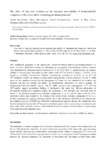Mostrar o rexistro simple do ítem
The effect of ring size variation on the structure and stability of lanthanide(III) complexes with crown ethers containing picolinate pendants
| dc.contributor.author | Roca Sabio, Adrián | |
| dc.contributor.author | Mato-Iglesias, Marta | |
| dc.contributor.author | Esteban-Gómez, David | |
| dc.contributor.author | Blas, Andrés de | |
| dc.contributor.author | Rodríguez-Blas, Teresa | |
| dc.contributor.author | Platas-Iglesias, Carlos | |
| dc.date.accessioned | 2017-10-27T13:04:21Z | |
| dc.date.available | 2017-10-27T13:04:21Z | |
| dc.date.issued | 2011-01-14 | |
| dc.identifier.citation | The effect of ring size variation on the structure and stability of lanthanide(III) complexes with crown ethers containing picolinate pendants. A. Roca-Sabio, M. Mato-Iglesias, D. Esteban-Gómez, A. de Blas, T. Rodríguez-Blas and C. Platas-Iglesias, Dalt. Trans., 2011, 40, 384–392. | es_ES |
| dc.identifier.issn | 1477-9226 | |
| dc.identifier.issn | 1477-9234 | |
| dc.identifier.uri | http://hdl.handle.net/2183/19648 | |
| dc.description.abstract | [Abstract] The coordination properties of the macrocyclic receptor N,N′-bis[(6-carboxy-2-pyridyl)methylene]-1,10-diaza-15-crown-5 (H2bp15c5) towards the lanthanide ions are reported. Thermodynamic stability constants were determined by pH-potentiometric titration at 25 °C in 0.1 M KCl. A smooth decrease in complexstability is observed upon decreasing the ionic radius of the LnIII ion from La [log KLaL = 12.52(2)] to Lu [log KLuL = 10.03(6)]. Luminescence lifetime measurements recorded on solutions of the EuIII and TbIII complexes confirm the absence of inner-sphere watermolecules in these complexes. 1H and 13C NMR spectra of the complexes formed with the diamagnetic LaIII metal ion were obtained in D2O solution and assigned with the aid of HSQC and HMBC 2D heteronuclear experiments, as well as standard 2D homonuclear COSY and NOESY spectra. The 1H NMR spectra of the paramagnetic CeIII, EuIII and YbIIIcomplex suggest nonadentate binding of the ligand to the metal ion. The syn conformation of the ligand in [Ln(bp15c5)]+ complexes implies the occurrence of two helicities, one associated with the layout of the picolinate pendant arms (absolute configuration Δ or Λ), and the other to the five fivemembered chelate rings formed by the binding of the crown moiety (absolute configuration δ or λ). A detailed conformational analysis performed with the aid of DFT calculations (B3LYP model) indicates that the complexes adopt a Λ(λδ)(δδλ) [or Δ(δλ)(λλδ)] conformation in aqueous solution. Our calculations show that the interaction between the LnIII ion and several donor atoms of the crown moiety is weakened as the ionic radius of the metal ion decreases, in line with the decrease of complex stability observed on proceeding to the right across the lanthanide series. | es_ES |
| dc.description.sponsorship | Ministerio de Educación y Ciencia; CTQ2006-07875 | es_ES |
| dc.description.sponsorship | Ministerio de Educación y Ciencia; CTQ2009-10721 | es_ES |
| dc.description.sponsorship | Galicia. Consellería de Economía e Industria; INCITE09E1R103013ES | es_ES |
| dc.language.iso | eng | es_ES |
| dc.publisher | Royal Society of Chemistry | es_ES |
| dc.relation.uri | https://doi.org/10.1039/C0DT00746C | es_ES |
| dc.subject | Picolinate ligands | es_ES |
| dc.subject | Crystal structures | es_ES |
| dc.subject | Lanthanide complexes | es_ES |
| dc.subject | Crown ethers | es_ES |
| dc.subject | Stability in solution | es_ES |
| dc.title | The effect of ring size variation on the structure and stability of lanthanide(III) complexes with crown ethers containing picolinate pendants | es_ES |
| dc.type | info:eu-repo/semantics/article | es_ES |
| dc.rights.access | info:eu-repo/semantics/openAccess | es_ES |
| UDC.journalTitle | Dalton Transactions | es_ES |
| UDC.volume | 40 | es_ES |
| UDC.issue | 2 | es_ES |
| UDC.startPage | 384 | es_ES |
| UDC.endPage | 392 | es_ES |
Ficheiros no ítem
Este ítem aparece na(s) seguinte(s) colección(s)
-
GI-REACT! - Artigos [103]






